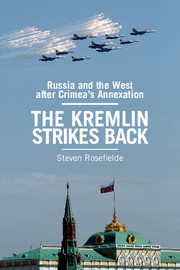Book contents
- The Kremlin Strikes Back
- The Kremlin Strikes Back
- Copyright page
- Dedication
- Contents
- Figures, Tables, and Maps
- Preface
- Acknowledgments
- Introduction
- Part I Crimea’s Annexation
- Part II Resurgent Cold War
- Part III Correlation of Forces
- Part IV Duty to Prevail
- Part V What Is to Be Done?
- Conclusion
- Bibliography
- Index
- References
Bibliography
Published online by Cambridge University Press: 16 February 2017
- The Kremlin Strikes Back
- The Kremlin Strikes Back
- Copyright page
- Dedication
- Contents
- Figures, Tables, and Maps
- Preface
- Acknowledgments
- Introduction
- Part I Crimea’s Annexation
- Part II Resurgent Cold War
- Part III Correlation of Forces
- Part IV Duty to Prevail
- Part V What Is to Be Done?
- Conclusion
- Bibliography
- Index
- References
- Type
- Chapter
- Information
- The Kremlin Strikes BackRussia and the West After Crimea's Annexation, pp. 277 - 290Publisher: Cambridge University PressPrint publication year: 2016



